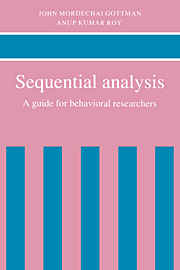Chapter 3 - The language of sequential analysis
from Part I - Introduction
Published online by Cambridge University Press: 10 November 2009
Summary
This section will introduce the words commonly used in sequential analysis. Usually, there is a set of coding categories: call them A1, A2, A3,…,AS. For example, in Ekman and Friesen's Facial Action Coding System (FACS), A1 might be the brows drawn down and together and A2 might be a nose wrinkle.
The general data situation is illustrated in Table 3.1. Each row represents a code, and each column represents a time interval. The time interval is presumed to be sufficiently small so that coding decisions can be reliably made. Time is used here in a general sense; for most of the techniques discussed in this book all that will matter, to preserve order, is that time 1 precedes time 2, and so on.
One advantage of displaying the data as they are in Table 3.1 is that every code can be represented as a binary time series. Another advantage is that we can add up all codes of a certain type and create a non-binary time series. For example, with the FACS we can add up all codes that indicate brow activity, or all codes that are predictors of sadness. An example of this is given by Tronick, Als, and Brazelton (1977), who graphed the sum of all the behaviors that represented the mother's involvement with her baby and subtracted the sum of all the behaviors that represented the mother's disengagement from the interaction. A similar time series was generated for the baby.
- Type
- Chapter
- Information
- Sequential AnalysisA Guide for Behavorial Researchers, pp. 15 - 32Publisher: Cambridge University PressPrint publication year: 1990



